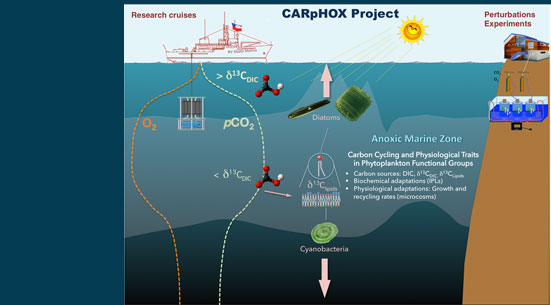On a global scale, there are extensive oxygen minimum zones (OMZ), areas that are expanding due to climate warming and the dynamics of greenhouse gases such as CO2. These are low pH/high pCO2 areas, resulting in significant CO2 emission from the ocean into the atmosphere. Furthermore, they are characterized by a secondary chlorophyll maximum, dominated by Prochlorococcus, where aerobic respiration and photosynthesis can occur under local turbulent mixing, which can occasionally cause intrusion of low pH/low O2 waters into the euphotic zone. Previous studies suggest that the tolerance and responses of phytoplankton to low pH/low O2 conditions are highly variable among lineages, therefore improving our knowledge about the influence of low pH/low O2 on phytoplankton functional groups, and their specific adaptations to these conditions will provide us with information on the impact of the expansion and reduction of O2 levels and the increase in pCO2. Thus, CARpHOX aims to address questions such as:
- What is the spatial/vertical heterogeneity of the carbonate system in the OMZ?
- What is the stoichiometry of nutrients, stable isotope signature, and recycling rates of inorganic carbon in low pH/low O2 waters in the OMZ?
- Are eukaryotic phototrophs occupying different niches in the water column of the OMZ regions exposed to different conditions during carbon fixation?, and
- What are the additive/synergistic physiological effects of low pH/low O2 conditions on functional groups of phytoplankton inhabiting the OMZ and overlying waters?
Our methodological approach includes expeditions to the OMZ in northern Chile, as well as mesocosm experiments that simulate low pH/low O2 conditions, investigating metabolic pathways using a multi-proxy approach including stable carbon isotopes and lipid biomarkers. Our approach uses laboratory CO2/O2 disturbance experiments to mimic corrosive and hypoxic conditions and to assess their impact on physiological traits, lipid membrane composition, and isotopic fractionation of phototrophic eukaryotes. In this proposal we want to identify and characterize important regulatory processes by studying the physiological and metabolic responses in the context of multiple stressors of climate change, critical information for understanding the carbon cycle in a changing ocean.

